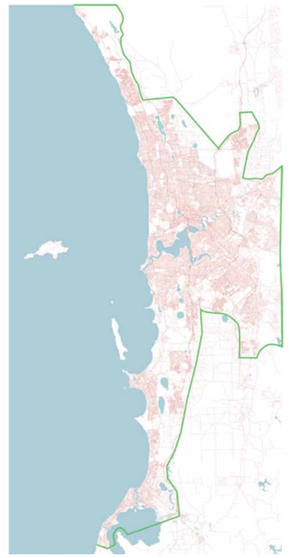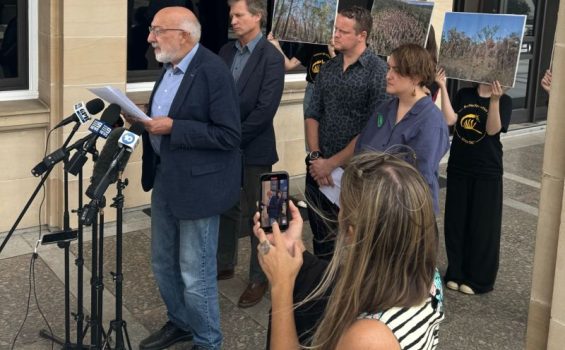
The Cost of Sprawl
31 October 2023
This issue of sprawl is at the heart of the Climate Positive Perth reports and the WA2.0 reports that went before them.
This is an issue in every capital city but Perth is the worst of the worst with the lowest targets and the lowest achieved infill of all Australia cities.
Perth’s metropolitan area is now one of the largest cities in the world by land size. Unlike other cities of a similar physical size we are very sparsely settled.
Perth’s physical size is roughly the same size as Los Angeles and Tokyo, but has only one tenth and one twentieth of their populations. In comparison, Tokyo has a land area size of 2,194km2 ,with a population of 13.96 million. New York City, with a population of 8.42 million, takes up just 783.8km2
Since 2016, Perth has continued to stretch to approximately 150km along the coastline. Greater Perth’s population grew by around 280,000 (or 14%), yet it got 30 km (25%) longer as it cleared hundreds of hectares more of one of only 36 global biodiversity hotspots, Earth’s most biologically rich — yet threatened — terrestrial regions.
Perth now holds the dubious distinctions of being the world’s longest city but also a relatively low density city by world standards with a world, with an average density of around 12 inhabitants per hectare.
Costs of sprawl
There is a huge hidden cost of business-as-usual sprawl; the cost of infrastructure in greenfield sites.
The scale of the problem was well recognised by the government and Department of Planning, Lands and Heritage (DPLH):
It is expected that by 2050 there will be an additional 1.5 million people living in the Perth
and Peel regions. To accommodate this level of growth it is estimated that 800,000 new
homes will be needed across the 19 local government areas in Perth’s metropolitan area.
Some 380,000 new homes will be built in existing suburbs to limit urban sprawl.
A sprawled Perth is a more expensive city, and it makes the transition to a low-carbon, more
sustainable city much harder.
The Environmental Protection Authority described the cost of continuing urban sprawl as ‘incalculable’. The State Infrastructure Strategy reveals that “…the cost of providing infrastructure to greenfield lots is 2 to 4 times more than infill development…” (page 131). Traffic congestion cost Perth an estimated $1.5 billion in 2016, according to Infrastructure Australia. That’s $4 million every day (ABC, 2022).
There is also considerable evidence that every house on the urban fringe costs 3 to 4 times as much in government supported physical and social infrastructure. Most recently the NSW Productivity Commission, showed that: The infrastructure costs of building new homes are lowest near Sydney’s CBD, increasing as development moves north, south, and west. The infrastructure-related costs of building further away can be up to $75,000 more per dwelling.
How is Perth going addressing sprawl
To reduce Perth’s urban sprawl, the Perth and Peel@3.5million frameworks set an infill development target of 47% by 2040. Infrastructure WA notes that Perth’s urban “…infill target is low compared to those set for some other Australian cities — 85 per cent in Adelaide by 2045 and an aspiration of 70 per cent in Melbourne by 2050”
Increasing Perth’s infill target from 47% to 60% would save $23 billion by 2050. A 100% infill target would save $53 billion by 2050.
In the last ten years has not Perth met its infill target of 47%, or the original 60% target set under the previous Network City plan. In fact, in recent years, infill has fallen to its lowest level in a decade.
By 2021, net infill dropped to 29%, according to the Urban Growth Monitor. Infill in Perth’s Central sub-region fell to a mere 2,820 dwellings — the lowest level since 2013. This means more than two-thirds of all new housing is currently being built on Greater Perth’s expansive urban fringe. This is housing a long way from services and facilities. Bunbury could become Perth’s most southern suburb at the rate we’re going.
Climate Positive Perth found that medium-density development along transport corridors could easily meet Perth’s ‘entire infill target’. It also demonstrated how activity corridors could transform Perth’s congested, car-heavy roads into vibrant and attractive high streets and urban villages.

Climate Positive Perth Key Recommendations
- Develop and fund an Urban Consolidation Plan that includes genuine and
interactive stakeholder and community engagement on how we plan for, design, and
build infill across Greater Perth. This Urban Consolidation Plan would include:
- A clearly defined urban growth/development boundary for greater Perth to put the brakes on sprawl and ensure a strong majority of new residents are in infill areas.
- Clearly defined, robust, and ambitious density targets including transparent public reporting on interim targets.
- A plan for Transit Oriented Developments (TODs) including required funding for implementation. This is likely to have a particular focus on Perth’s heritage train lines.
- A plan for Transit Activated Corridors (TACs), including requiring funding with a clear link to mid-tier transit in the central sub-region.
2. Provide incentives for new, well-located apartment developments. This could
include full stamp duty exemptions, removal of foreign buyer surcharge, reduction
of financial disincentives to downsizing from houses to apartments, prioritised
approvals processes, and state government direct funding to apartment projects.
- Provide incentives for local governments to meet density targets through
infrastructure funding pools exclusively for those local governments who meet and
exceed targets


I welcome the three Climate Positive Perth Key Recommendations.
However, I would like to have seen mention of the need for low – medium density (maximum six storey) apartment development in appropriate locations. That is, a compromise position between single residential and high rise – a sensible outcome that would resonate with many residents in areas with existing high standard infrastructure.
The case for medium rise is underlined by the emerging high rise skylines in the Canning Bridge and South Perth Activity Centres. These examples are very likely to prejudice many against the infill imperative. Why lurch from one extreme (single residential) to another (high rise), when the middle course (medium rise) is an obvious and relatively attractive solution?